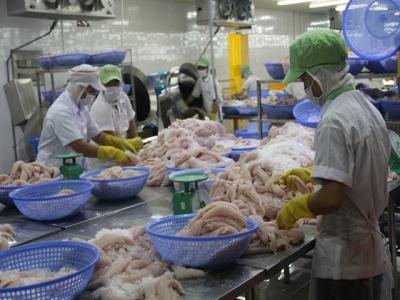Mekong Delta urged to apply hi-tech in fish farming

Việt Nam’s catfish exporters found it more challenging to export to the US market after the US Department of Commerce (DOC) imposed high anti-dumping duties on frozen catfish fillets imported from Việt Nam. — VNA/VNS Photo Minh Trí
Minister of Agriculture and Rural Development Nguyễn Xuân Cường has urged the Cửu Long (Mekong) Delta provinces, especially An Giang Province, to apply advanced technologies in production of tra fish (catfish).
Speaking at a conference held on August 21 in An Giang Province, Cường said that catfish exports should reach more than $2 billion as no other country has the advantage that Việt Nam does in this sector.
He said one of the key solutions for pangasius farming was “sustainable development” through cutting-edge technologies.
“Provinces must re-plan production and diversify their products, with priority given to value-added products. They should also diversify export markets,” he added.
Như Văn Cẩn, head of the Department of Aquaculture under Directorate of Fisheries, said in the first seven months, the catfish industry faced a number of challenges, including barriers from import markets.
An anti-dumping duty and a catfish inspection programme prevented local seafood enterprises from promoting exports of catfish to the US market.
Việt Nam’s catfish exporters found it more challenging to export to the US market after the US Department of Commerce (DOC) imposed high anti-dumping duties on frozen catfish fillets imported from Việt Nam.
DOC has announced that nine Vietnamese enterprises entitled to separate tariffs will be subject to US$3.87-7.74 per kg, a record-high rate.
Exports of catfish to the EU continue to decline. In addition, Saudi Arabia continues to suspend imports of seafood products from Việt Nam.
While China remains a consumer of Vietnamese pangasius products, it is likely to become a potential catfish supplier to the world, which also poses a barrier for the Vietnamese pangasius industry.
Despite challenges, exports in the first seven months continued to increase by 19.3 per cent over the same period last year, reaching $1.198 billion.
In the first seven months, catfish exports to China reached $289.8 million, accounting for 24.2 per cent of the market share, and up 40.6 per cent over the same period.
Many businesses at the conference said the quality of the breed is the most important factor.
They also proposed producing seed varieties with high technology to limit diseases.
Catfish seed project
Regarding the high-quality catfish breeding project, most of the participants agreed that it would be a new step for the catfish industry.
It is expected that the catfish chain of Việt Nam will be strictly controlled, from the first to final stage in the production chain.
In March, the Ministry of Agriculture and Rural Development approved a project on producing high-quality catfish species in the Mekong Delta.
The project aims to contribute to the development of the catfish industry in a sustainable manner to meet the requirements of national and international markets.
Under the project, the three-level catfish fingerling production chain would meet 50 per cent of the demand for high-quality catfish in the Mekong Delta by 2020, and 100 per cent of demand for high-quality catfish species by 2050.
The project will build up a chain of catfish production in the region, focusing on An Giang and Đồng Tháp provinces in the region.
The concentrated area for catfish species must be in line with the local land use planning, with an area of 50 hectares or more, convenient for water sources and environmentally sound, in accordance with regulations.
Speaking with Việt Nam News in a recent interview, Trương Đình Hòe, general secretary of the Việt Nam Association of Seafood Exporters and Producers (VASEP), said in order to export aquatic products to foreign markets, enterprises must comply with requirements on quality, food hygiene and safety.
Vietnamese businesses have been focusing on improving the fisheries production chain, from seed production to cultivation, processing and exporting, he said.
Many companies have been awarded international certificates and are qualified to export catfish fish to high-end markets such as the US and the EU, he said.
Therefore, to maintain export market share, the most important prerequisite is still quality, he said, adding the price of products is also a key factor.
Many companies have updated technology in the value chain, thus the production cost should be further optimised to compete with other aquatic products such as whitefish, tilapia or American catfish, Hòe noted.
VASEP is seeing a recovery in the EU and South America, as well as good growth in the Chinese market with increasing demand for high value products. This shows that Vietnamese catfish is still attractive in the world market.
The seminar was held to review the production and consumption of catfish and implementation of the high-quality pangasius breeding project.
Related news
 Tuna exports likely to hit $500m in 2018
Tuna exports likely to hit $500m in 2018 Việt Nam’s tuna export revenue is likely to reach the target of US$500 million in 2018 after hitting $351 million in the first seven months of this year
 Gene expression response to sea lice in salmon skin identified
Gene expression response to sea lice in salmon skin identified Sea lice have major negative economic and animal welfare impacts on global salmon aquaculture.
 Testing low-cost demand carp feeders in Nepal
Testing low-cost demand carp feeders in Nepal Results of a study in Nepal using low-cost demand feeders for farmed carp production demonstrated the potential of this simple technology to help Nepalese fish